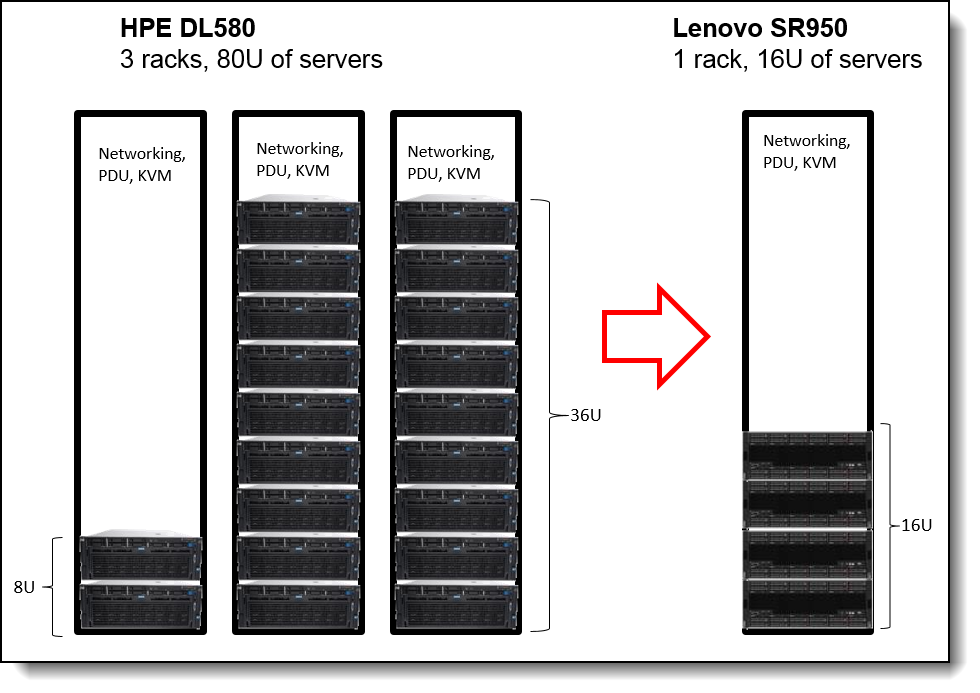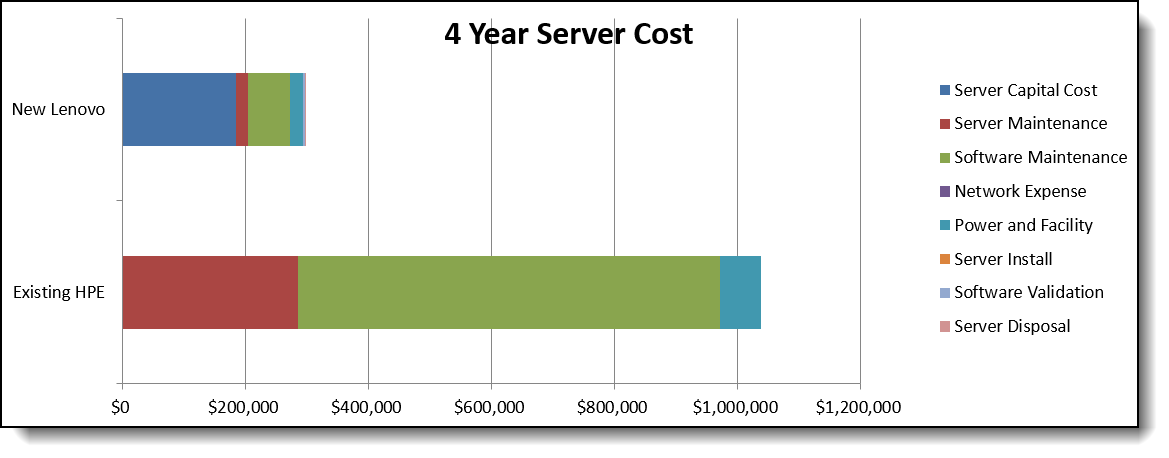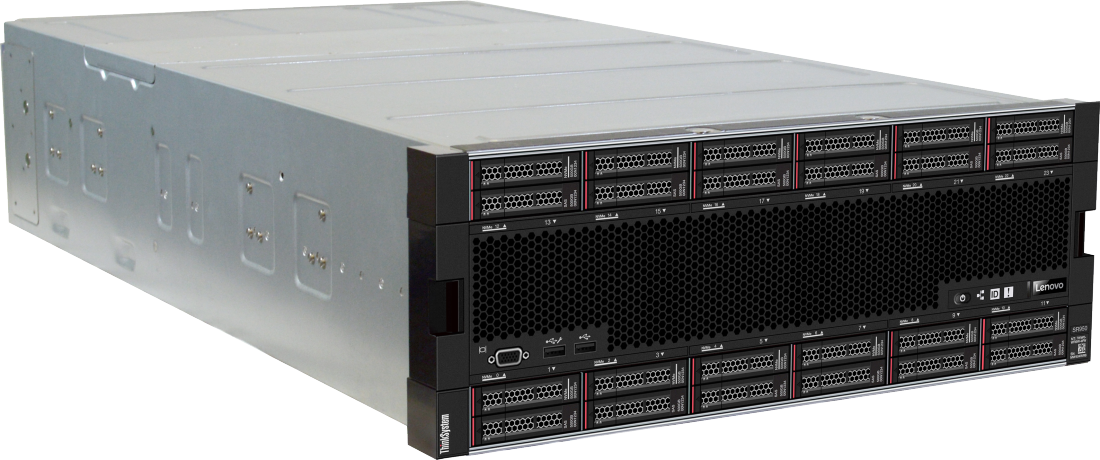Author
Published
22 Sep 2017Form Number
LP0753PDF size
10 pages, 1.1 MBAbstract
By replacing older 4-socket servers with new Lenovo ThinkSystem SR950 servers, companies can significantly reduce operational cost, increase agility, improve efficiency and reduce datacenter space with a payback less than 12 months.
This article looks at the reasons to refresh older 4 socket servers and provides a case study that provides quantitative total cost of ownership (TCO) analysis and benefits.
Video Introduction
Introduction
Today’s 4-socket servers last longer than ever, but data centers will inevitably need to purchase new servers. There comes a point when server hardware is simply too old to perform effectively. The key is to identify when increased performance, energy-efficiency requirements, maintenance cost and reduced risk of hardware failure will justify a new purchase.
The incentive for refreshing your servers is being able to do more to support the business and mission-critical goals of the organization. Spurred by new technologies and virtualization, servers are running faster processors with greater numbers of cores and threads per processor, thereby enabling greater computing capabilities. By refreshing servers in a timely fashion, companies can avoid operating costs that increase significantly after 3 year of a server’s life span and substantially outweigh the initial cost of buying a new server while benefiting from improved performance, agility and reduced maintenance.
By replacing older, less capable servers with newer, more powerful Lenovo ThinkSystem servers, a business can perform the same amount of computing with only a fraction of the total number of systems. Most companies achieve their business objectives by improving application performance and scalability, reducing IT sprawl and complexity, lowering hardware and licensing costs, and by operating an environmentally “green” data center.
In many cases the new servers reduces annual server related operating costs by up to 70% or more, and pays for itself in less than a year based on technology advancements, the low cost of server hardware, and dramatically improved air-conditioning requirements. This is especially true as your workloads grow and you’re trying to lower your management, power and cooling costs at the same time.
Reasons for Refreshing Servers
There are many reasons you should consider for refreshing your servers.
- Consolidation
Fewer machines mean smaller numbers of boxes to manage, maintain and physically house in expensive data center real estate. When one new ThinkSystem does the work of four or five older servers, the environment becomes easier to manage. An additional benefit to a smaller server footprint is a reduction in the number of maintenance contracts.
- Productivity
IT departments are pushed to increase performance and business capabilities, often without additional funds. Each new generation of servers delivers baseline performance gains between 15 and 40 percent. The latest Lenovo ThinkSystem servers can address higher volumes of memory than previous generations. The more data you can put in memory, the faster that data can be processed. Moving to the new ThinkSystem architecture to reduce processing latencies can be particularly important for performance-intensive industries. The latest ThinkSystem servers also support NVMe storage which greatly increases the reading and writing on data compared to spinning drives or even SAS/SATA SSDs.
- Operating system advancements
In many cases, an older server cannot support the latest operating systems from Microsoft, VMware and Linux. The latest operating systems have new capabilities or improvements with virtualization, reliability, security, storage handling, provisioning, server management and licensing. The new operating systems also take advantage of the latest ThinkSystem and Intel processor features.
- Lower maintenance and warranty cost
New servers typically come with a 3 year warranty. After the third year server hardware maintenance and warranty become expensive to maintain while the likelihood of server hardware and software issues increases as it gets older.
- Power and cooling
Moving to the latest ThinkSystem generation typically results in a significant savings in power consumption. The less power consumed by servers means less heat generated and lower losses for power distribution. This also reduces the cost of heat extraction. Lowering server power consumption, along with controlling that consumption, may allow the deployment of additional servers per rack while keeping within an overall power budget. In many cases, between two generations of servers, you can nearly double compute performance using an equivalent amount of wattage.
- Business operations
New ThinkSystem servers provide increased processing capability, improved storage, faster I/O and increased memory enable client applications and processes to run faster and more efficiently, and overcome workloads problems. This allows company processes to run smother, handle big-data analytics and react quicker to ever-changing customer demands. The increased RAS capabilities of the new ThinkSystem servers means mission-critical applications such as database, enterprise resource planning (ERP), customer resource management (CRM), and business intelligence (BI) applications are available 24/7 on a global basis.
Case Study Introduction
This case study summarizes the business case of a large manufacturing company that has decided to migrate their mission critical applications from 20 HPE DL580 servers that are four years old to four Lenovo ThinkSystem SR950 servers running Microsoft Windows Server 2016 and VMware vSphere Enterprise.
The decision to replace the older servers was made after changes to the company’s strategic business plan made it necessary to consolidate data center equipment and integrate systems to improve efficiency and gain the technology advancements necessary to support their business plan.
Their requirements for reducing data center space and lowering of operating cost as well as providing a high performing, scalable and flexibility system drove the company to investigate its refresh options and to a decision favoring a Lenovo ThinkSystem SR950 over other alternatives. Significant cost savings and favorable ROI were key factors in the decision.
Case Study Overview
Based on its financial assessment the company determined it could save 71% or $740,731 over 4 years by migrating its mission critical applications to four ThinkSystem SR950 servers instead of maintaining twenty HPE DL580 servers. With a superior price to performance ratio and advanced features, the ThinkSystem SR950 offers significant savings in capital costs, operating expenses, employee productivity costs, and potential revenue impacts.
The following table summarizes the existing and new server solution.
Rack Space Consolidation
Due to the tremendous performance of the Lenovo ThinkSystem SR950, the company was able to convert 3 racks and 80U of server space with the HPE DL580 servers to 1 rack and 16U of server space. This provides a savings of 64U of rack space.

Figure 1. Consolidating 3 racks and 80U of servers to 1 rack and 16U of servers
Investment Analysis
The company expects the ThinkSystem SR950 to deliver a Return on Investment (ROI) of 392% when comparing their total investment of $188,908 for server hardware and migration costs with four year net benefits of $740,731. Table 2 below summarizes the Investment Analysis and return on investment (ROI) that the ThinkSystem SR950 server is expected to provide.
Four-Year Server Cost Summary
In addition to the four-year TCO comparison, the company was interested in focusing on specific costs directly associated with the server environment – specifically hardware, software, support, licensing, system administration, operations, environmental, and migration costs. Table 3 below shows a comparison of these costs for the current HPE servers versus the ThinkSystem SR950 servers.

Figure 2. Four-Year Server Cost
Hardware Purchase Cost
The proposed solution included four ThinkSystem SR950 servers with four Intel Xeon 6130 Scalable Processors each. Each SR950 occupies a 4U rack footprint and was configured with 1 TB of 2666 MHz RDIMM memory. The production workload from 20 physical HPE servers was consolidated into 4 SR950 servers.
Hardware Maintenance
To maintain the server hardware, the annual maintenance cost is a significant expense. Replacing 20 of the HPE servers with only four of the ThinkSystem servers saves $265,519 or 93% in hardware maintenance cost. Table 5 provides the annual server hardware maintenance cost to maintain the older HPE hardware vs the new ThinkSystem SR950 hardware. The first 3 years of the ThinkSystem support is included in the initial purchase price of the servers.
Software Maintenance Fees
For both the old HPE systems and new ThinkSystem SR950 systems, the company uses Microsoft Windows 2016 Datacenter and VMware VSphere Enterprise. Replacing 20 of the HPE servers with only four of the ThinkSystem servers saves $617,040 or 90% in software maintenance cost. Table 6 projects the software maintenance fees to maintain the current HPE server hardware vs the software fees to on the new ThinkSystem SR950 servers over the same 4 year period.
Network Costs
Replacing 20 of the HPE servers with only four of the ThinkSystem servers saves $960 or 80% in power and facility cost. Network equipment cost for the current HPE server infrastructure and the new ThinkSystem SR950 infrastructure over the four year period is provided in Table 7.
Power and Facility Cost (Green Impact)
The Lenovo ThinkSystem SR950 and HPE DL580 servers both require 4U of standard rack space. Replacing 20 of the HPE servers with only four of the ThinkSystem servers frees up 64U of rack space in the datacenter and saves $46,120 or 70% in power and facility cost. Power and Facility cost for the current HPE server infrastructure vs the new ThinkSystem SR950 infrastructure over the four year period is provided in Table 8.
Other Costs
Other cost incurred for the new Lenovo servers and the TCO analysis is software install, software validation and server disposal. These cost are provided in Table 9.
About ThinkSystem SR950
The Lenovo ThinkSystem SR950 is a 4U Rack server capable of up to 8 processors and 96 DIMM. The SR950 features a modular system with all components accessible via the front or rear of the server. Clients can configure multiple configurations from 2 socket -24 DIMM to 8 socket- 96 DIMMs. The SR950 is designed for your most demanding, mission-critical workloads, such as in-memory databases, large transactional databases, real-time analytics, ERP, CRM, and virtualized server workloads.
The following figure shows the Lenovo ThinkSystem SR950.

Figure 3. Lenovo ThinkSystem SR950
Conclusion
This case study shows that organizations can significantly reduce operational cost, increase agility, improve efficiency and reduce datacenter space with refreshing older four socket servers with the new Lenovo ThinkSystem SR950 while providing a payback in less than 12 months.
Further reading
For further reading, see these resources
This article is one in a series on the ThinkSystem SR950 and SR850 servers:
- Five Highlights of the ThinkSystem SR950
- Five Highlights of the ThinkSystem SR850
- Choosing between Lenovo ThinkSystem SR850 and SR950
- Workloads for 4-Socket and 8-Socket Servers
- Usability in the Design of the ThinkSystem SR950
- The Value of Refreshing Your 4-Socket Servers with the ThinkSystem SR950
- ThinkSystem SR950 Memory Decisions
- ThinkSystem SR950 Server Configurations
- The Value of Refreshing Your 8-Socket Servers with the ThinkSystem SR950
- Lenovo ThinkSystem SR950 New Options and Features - December 2017
- ThinkSystem SR950 Performance Leadership
- Lenovo Servers for Mission Critical Workloads
- Microsoft and Lenovo ThinkSystem SR950 – A Perfect Match
- Accelerate Your 4- and 8-Socket Server Refresh Cycle
- SAP Business Process Applications and Lenovo ThinkSystem SR950 – A Perfect Match
- ThinkSystem SR950 New Options - March 2018
- SAP HANA and Lenovo ThinkSystem SR950 – A Perfect Match
- ThinkSystem SR950 Performance Leadership Continues
- New Solution for SAP HANA - Lenovo ThinkAgile HX
- The Advantages of Keeping Mission Critical Workloads On-Premises vs Going to the Cloud
About the author
Randall Lundin is a Senior Product Manager in the Lenovo Infrastructure Solution Group. He is responsible for planning and managing ThinkSystem servers. Randall has also authored and contributed to numerous Lenovo Press publications on ThinkSystem products.
Trademarks
Lenovo and the Lenovo logo are trademarks or registered trademarks of Lenovo in the United States, other countries, or both. A current list of Lenovo trademarks is available on the Web at https://www.lenovo.com/us/en/legal/copytrade/.
The following terms are trademarks of Lenovo in the United States, other countries, or both:
Lenovo®
ThinkAgile®
ThinkSystem®
The following terms are trademarks of other companies:
Intel®, the Intel logo and Xeon® are trademarks of Intel Corporation or its subsidiaries.
Linux® is the trademark of Linus Torvalds in the U.S. and other countries.
Microsoft®, Windows Server®, and Windows® are trademarks of Microsoft Corporation in the United States, other countries, or both.
Other company, product, or service names may be trademarks or service marks of others.
Configure and Buy
Full Change History
Course Detail
Employees Only Content
The content in this document with a is only visible to employees who are logged in. Logon using your Lenovo ITcode and password via Lenovo single-signon (SSO).
The author of the document has determined that this content is classified as Lenovo Internal and should not be normally be made available to people who are not employees or contractors. This includes partners, customers, and competitors. The reasons may vary and you should reach out to the authors of the document for clarification, if needed. Be cautious about sharing this content with others as it may contain sensitive information.
Any visitor to the Lenovo Press web site who is not logged on will not be able to see this employee-only content. This content is excluded from search engine indexes and will not appear in any search results.
For all users, including logged-in employees, this employee-only content does not appear in the PDF version of this document.
This functionality is cookie based. The web site will normally remember your login state between browser sessions, however, if you clear cookies at the end of a session or work in an Incognito/Private browser window, then you will need to log in each time.
If you have any questions about this feature of the Lenovo Press web, please email David Watts at dwatts@lenovo.com.
